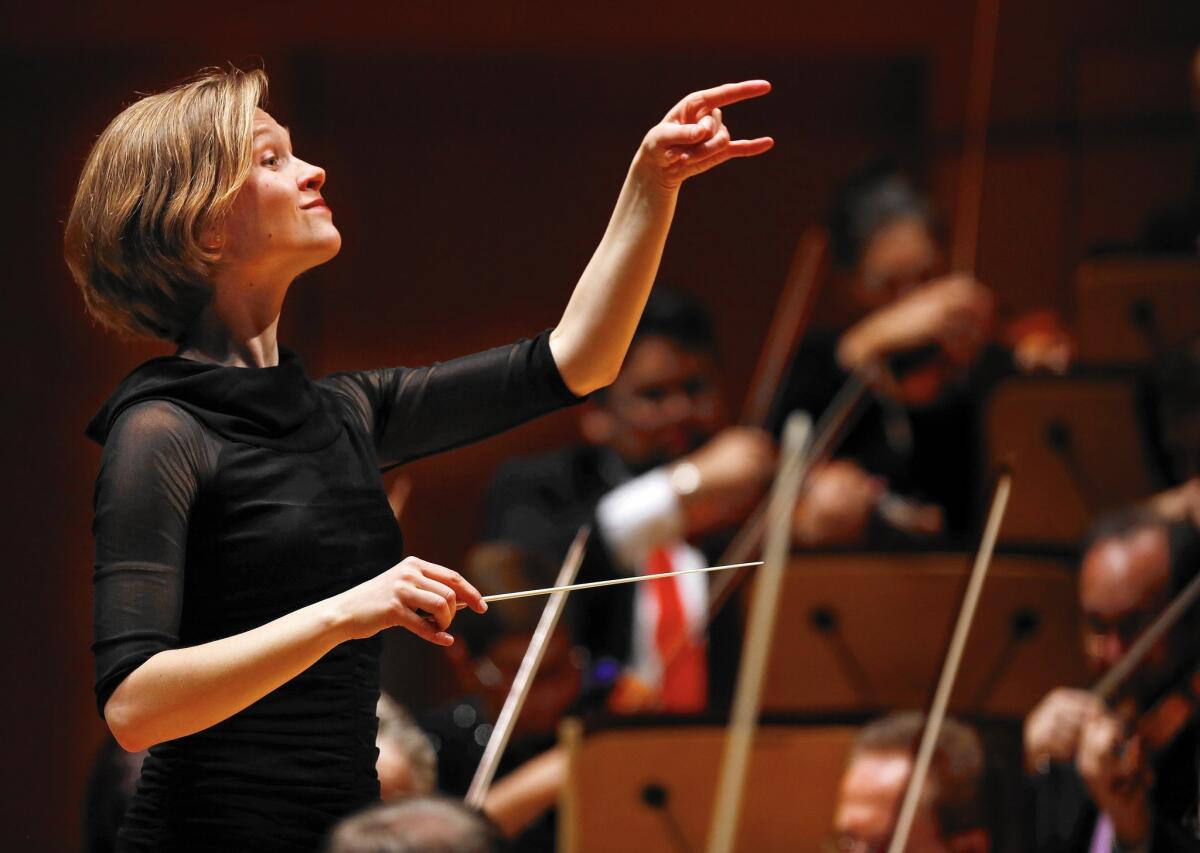Review: L.A. Phil’s Mirga Grazinyte-Tyla lights a fire at Disney Hall

- Share via
There is no such thing as a fluke Hollywood Bowl triumph. Given the combination of severely limited rehearsal time, amplification and summer orchestral doldrums, so much can go wrong that an outstanding conductor can easily make a poor first impression.
So when a young conductor wows, as a 28-year-old newly appointed Los Angeles Philharmonic assistant conductor did at her Bowl debut last August, it’s big news.
Mirga Grazinyte-Tyla’s reward for that rare debut was her first L.A. Phil subscription concert at Walt Disney Concert Hall on Sunday afternoon. Word was out. The hall sold out. Presenters from Chicago, New York and elsewhere came to check her out. Managers who didn’t were simply not paying attention.
ESSENTIAL ARTS & CULTURE NEWSLETTER >> Get great stories delivered to your inbox
The debut was a preview. Mirga mania can now officially begin.
Sunday’s matinee was standard Mozart-Beethoven-Stravinsky repertory. Once more, Grazinyte-Tyla’s situation, if far better than at the Bowl, wasn’t optimal. Her rehearsals had to be squeezed into a week that included what was probably the most demanding project that any American orchestra would attempt this season — Unsuk Chin’s complex opera “Alice and Wonderland,” on Friday and Saturday at Disney Hall.
Grazinyte-Tyla’s program obviously needed to contain scores that the orchestra knew well. Even so, Mozart’s Overture to “The Abduction From the Seraglio,” Stravinsky’s “Petrushka” and Beethoven’s Seventh Symphony reveal Grazinyte-Tyla’s strengths, particularly her capacity to create rhythmic excitement. And with playing as good as she was able to get from a highly energized L.A. Phil, no excuses were necessary.
She didn’t so much begin these three pieces; she ignited them. Conducting from memory, she waved her long, slender arms with a persuasive animation not only intended to shape phrases and cue players but also to seemingly bat away any resistance to musical momentum.
She jumped into the “Abduction” overture, interested not in the comic implications of the opera but the percussive newness of Mozart’s take on Turkish music. But she also demonstrated her ability to mold fluid melodic lines and bring out inner details without ever losing that incredible momentum.
In “Petrushka,” Grazinyte-Tyla did not try to tell the ballet’s story of a puppet that comes touchingly to life so much as set the boisterous scene of Russian street and theater life. The winds chattered with rowdy glee. Thomas Hooten’s lustrous trumpet solos focused attention on individuality. The luminous colors of Joanne Pearce Martin’s piano solos evoked something more magical than mere merriment.
One thing Grazinyte-Tyla is not is sentimental, and the concept of momentum keeps coming up. This was a “Petrushka” on the move. For all its gripping details, Grazinyte-Tyla’s performance of “Petrushka” was never an occasion for dwelling on any of them. The conductor shed no tear for the poor puppet at the end. She brought a natural process to a natural conclusion.
Momentum was the determining factor in a breathtaking Beethoven Seventh as well. The dotted rhythms that make this Beethoven’s dance symphony were the expected indefatigable engine of the performance. Grazinyte-Tyla’s emphasis on harmonic intensity was the surprise.
She employed a small orchestra and lighted her spark by digging into the texture of individual chords. Each here was like an ingredient in a chemical compound that, when the last drop is added, will explode.
With that explosion, Grazinyte-Tyla then led a nearly nonstop Seventh. The timpani played by Nicholas Stoup in both the Mozart overture and Beethoven’s symphony were small period instruments that made a stinging whip-crack of a sound rather than the boom of the bigger modern instruments.
The vivacious first movement flowed into the more somber second without a break, passing from light to dark as if through a tunnel where you knew about the light at the other end. The Scherzo sounded as rhythmically vivid as the Stravinsky, although Grazinyte-Tyla made a grand statement of the middle trio section.
The last movement was again a representation of momentum at work, but a sly one. Grazinyte-Tyla began the Finale with deceptive understatement, a nonthreatening romp. Her revelation is that when rolling Beethoven picks up no moss, it gains massive momentum.
A glass ceiling in orchestral culture is said to still be intact, if growing weaker by the minute. I wouldn’t worry. Grazinyte-Tyla was the third exceptional woman to conduct the L.A. Phil in a week. Xian Zhang led the orchestra’s Chinese New Year’s celebrations; Susanna Malkki headed the massive “Alice” enterprise.
All are going places. We haven’t yet had a chance to sense Grazinyte-Tyla’s musical range. But if nothing stops her Beethoven, nothing’s going to stop her. Pretty soon, we’ll all know how to pronounce her name. Grazinyte-Tyla (GRA-chin-tee-eh TEE-lah) will be back at the Hollywood Bowl this summer.
More to Read
The biggest entertainment stories
Get our big stories about Hollywood, film, television, music, arts, culture and more right in your inbox as soon as they publish.
You may occasionally receive promotional content from the Los Angeles Times.











